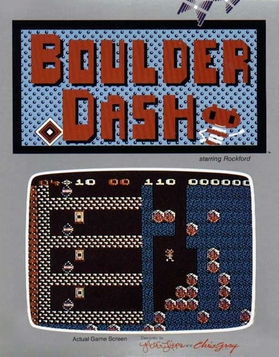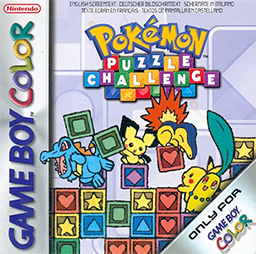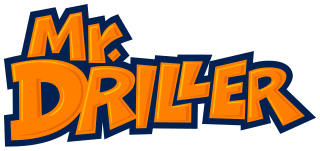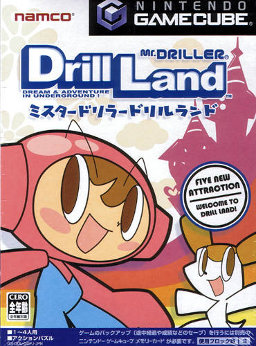
Dr. Mario is a 1990 puzzle video game developed and published by Nintendo for the Nintendo Entertainment System, Famicom, and Game Boy. It was produced by Gunpei Yokoi and designed by Takahiro Harada. The soundtrack was composed by Hirokazu Tanaka.

Tetris Attack, also known as Panel de Pon in Japan, is a puzzle video game developed by Intelligent Systems and published by Nintendo for the Super Nintendo Entertainment System. A Game Boy version was released a year later. In the game, the player must arrange matching colored blocks in vertical or horizontal rows to clear them. The blocks steadily rise towards the top of the playfield, with new blocks being added at the bottom. Several gameplay modes are present, including a time attack and multiplayer mode.

The Legend of Zelda: Oracle of Seasons and The Legend of Zelda: Oracle of Ages are two 2001 action-adventure games in The Legend of Zelda series, developed by Flagship and published by Nintendo for the Game Boy Color.

A Boy and His Blob: Trouble on Blobolonia is a puzzle-platform game developed by Imagineering and published by Absolute Entertainment for the Nintendo Entertainment System (NES). The video game was released in North America in 1989, in Europe by Nintendo in 1991 and in Japan by Jaleco in 1991. A Boy and His Blob follows an unnamed male protagonist and his shapeshifting blob friend on their adventure to save the planet of Blobolonia from the clutches of an evil emperor.

ChuChu Rocket! is an action puzzle game developed by Sonic Team and published by Sega. Released for the Dreamcast in 1999, it was the first game for the system to support online console gaming. Players must place arrows on a board to lead mice into escape rockets while avoiding cats. The game features single-player modes in which a player must save all the mice on a board, and a multiplayer mode in which players battle to collect the most mice.

Wario's Woods is a puzzle video game developed by TEC and published by Nintendo for the Nintendo Entertainment System. It was released in Japan and North America in 1994 and Europe in 1995. A spin-off of the Mario series, players control Toad in his mission to defeat Wario, who has taken control of the Peaceful Woods. Gameplay revolves around clearing each level by using bombs to destroy groups of enemies. The game also features a multiplayer mode that allows two players to compete against each other.

Pokémon FireRed Version and Pokémon LeafGreen Version are 2004 remakes of the 1996 role-playing video games Pokémon Red and Blue. They were developed by Game Freak and published by The Pokémon Company and Nintendo for the Game Boy Advance. FireRed and LeafGreen were first released in Japan in January 2004 and in North America and Europe in September and October 2004. The games are part of the third generation of the Pokémon video game series and hold the distinction of being the first enhanced remakes of previous games within the franchise.

Boulder Dash is a 2D maze-puzzle video game released in 1984 by First Star Software for Atari 8-bit computers. It was created by Canadian developers Peter Liepa and Chris Gray. The player controls Rockford, who collects treasures while evading hazards.

Tony Hawk's Pro Skater 2 is a 2000 skateboarding video game developed by Neversoft and published by Activision. It is the second installment in the Tony Hawk's series of sports games and was released for the PlayStation in 2000, with subsequent ports to Microsoft Windows, Game Boy Color, and Dreamcast the same year. In 2001, the game was ported to the Mac OS, Game Boy Advance, Nintendo 64, and Xbox. The game was later ported to Windows Mobile and Windows Phone devices in 2006 and to iOS devices in 2010.

Pokémon Puzzle Challenge is a puzzle video game developed by Intelligent Systems and published by Nintendo for the Game Boy Color. Released in Japan on September 21, 2000; in North America on December 4, 2000; and in PAL regions on June 15, 2001, it is the second Pokémon-themed entry in the Puzzle League series. While its Nintendo 64 counterpart Pokémon Puzzle League is visually based on the Pokemon anime, Puzzle Challenge instead draws inspiration from the Pokémon Gold and Silver games. The game features multiple modes of play and support for competitive play between two players. Puzzle Challenge was later digitally re-released via the Nintendo 3DS's Virtual Console line on November 6, 2014.

Mr. Driller is a puzzle video game franchise created by Yasuhito Nagaoka and Hideo Yoshizawa for Namco. The eponymous first game was released in 1999 for arcades and several home consoles, such as the PlayStation. Gameplay in the series consists of controlling Susumu Hori, the titular Mr. Driller, or one of his friends and destroying colorful formations of blocks to make it to the bottom of a well. In order to survive, players need to collect air capsules to replenish their depleting oxygen and avoid being crushed by falling blocks.

Lumines: Puzzle Fusion is a 2004 puzzle game developed by Q Entertainment and published for the PlayStation Portable by Bandai in Japan and by Ubisoft elsewhere. The objective of the game is to arrange descending two-colored 2×2 blocks to create 2×2 squares of matching color. A vertical line known as the "time line" sweeps across the field, erases completed squares, and awards points. Each stage has a skin that affects the background, block colors, music, and the speed of the time line.

Zoo Keeper is a tile-matching video game originally developed and published by Robot Communications for browsers. It was later ported to the Game Boy Advance, PlayStation 2 and Nintendo DS by Success, which remains its best known incarnation. Zoo Keeper was released for arcades in 2004. The game was then brought to American and European shores by Ignition Entertainment, and has since been released for iOS and Android devices under the title Zookeeper DX Touch Edition by Kiteretsu.

Pac-Attack, also known as Pac-Panic, is a 1993 falling-tile puzzle video game developed and published by Namco for the Super Nintendo Entertainment System and Sega Genesis. Versions for the Game Boy, Game Gear and Philips CD-i were also released. The player is tasked with clearing out blocks and ghosts without them stacking to the top of the playfield — blocks can be cleared by matching them in horizontal rows, while ghosts can be cleared by placing down a Pac-Man piece that can eat them. It is the first game in the Pac-Man series to be released exclusively for home platforms.

Lego Star Wars II: The Original Trilogy is a 2006 Lego-themed action-adventure game developed by Traveller's Tales and published by LucasArts and TT Games Publishing. It was released on 11 September 2006. Part of the Lego Star Wars series, it is based on the Star Wars science fiction media franchise and Lego Group's Lego Star Wars construction toy line. It follows the events of the Star Wars films A New Hope, The Empire Strikes Back and Return of the Jedi. The game allows players to assume the roles of over 50 Lego versions of characters from the film series; customized characters can also be created. Camera movement was improved from its predecessor Lego Star Wars: The Video Game and the concept of "vehicle levels" was explored more thoroughly. The game was revealed at American International Toy Fair. Promotions for the game were set up at chain stores across the United States.

Sonic Jump is a 2005 vertical platform game developed by AirPlay and Sonic Team, and published by Sega for the digital distribution service Sonic Cafe, initially only available in Japan for mobile phones before being ported to iOS and Android and released in other regions in 2007. Unlike other games in the series, Sonic Jump doesn't involve running from left to right, but instead, Sonic automatically jumps up the screen, with the player needing to tilt the phone to move him from left to right. The original game's graphical style is based on the Sonic Advance series, which had ended shortly before Jump's release.

Mr. Driller Drill Land is a 2002 puzzle video game developed and published in Japan by Namco for the GameCube. It is the fifth entry in the Mr. Driller video game series, and the second developed for a Nintendo platform following Mr. Driller A. Controlling one of seven characters, the player must make it to the bottom of each stage by destroying colored blocks, which can connect to each other and form chain reactions. The game is divided into five different modes themed as amusement park attractions, which feature new mechanics such as enemies, items and different block types.

Denki is an interactive television and console game developer based in Dundee, Scotland. The company is the developer of over 180 console and interactive television games, covering a range of platforms. Denki has worked extensively in the digital interactive television (IDTV) market, with the majority of their titles created specifically for digital interactive television DirecTV platform.

Mr. Driller 2 is a puzzle video game developed and published by Namco, and the second game in the Mr. Driller series. It was released for the arcades in 2000, and was ported to the Game Boy Advance and Windows in 2001, and is available in emulated form via the Virtual Console on the Wii U. The game introduces two new characters to the series, Puchi, and Anna.

Mr. Driller is a 1999 puzzle arcade game developed and published by Namco. Versions for the PlayStation, Dreamcast, Microsoft Windows, Game Boy Color, WonderSwan Color, mobile phones, and iOS were also released. Controlling Susumu Hori, the titular "Mr. Driller", the player must dig their way to the bottom of the screen by destroying colored blocks that litter the playfield. Blocks will be cleared if four or more are touching each other, which can be used to cause chain reactions. Susumu has a constantly-depleting oxygen meter that can be refilled by collecting air capsules found throughout stages.




















